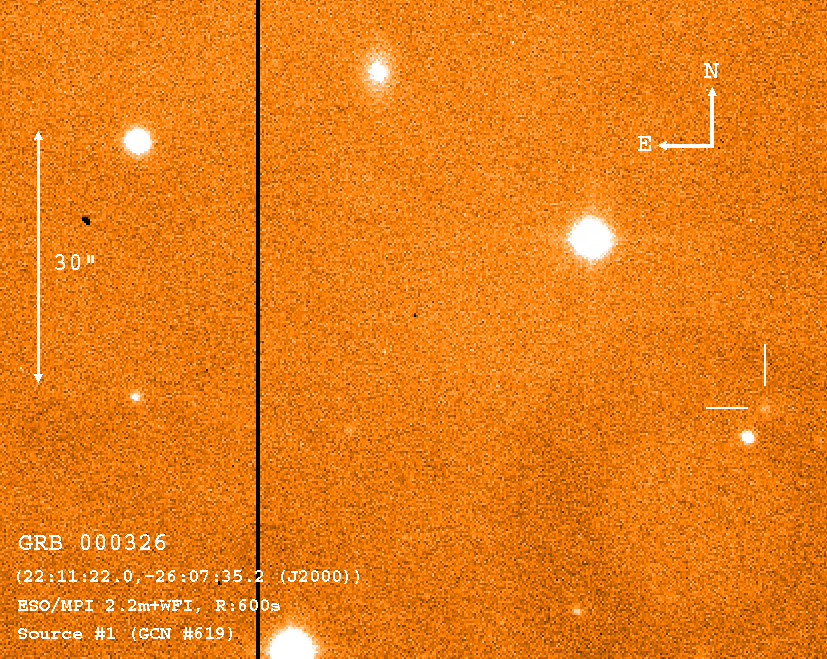
Gamma-ray Burst 000326

On March 26, 2000, 5:18:54 UT Earth-crossing time, a GRB was detected
by Ulysses, NEAR and Konus.
(All information courtesy of the instrument teams.)
 Previous IAU Circulars
Previous IAU Circulars
 Results of Observations
Results of Observations
- GCN notice #618
K. Hurley, E. Mazets, and T. Cline, on behalf of the Ulysses,
KONUS-Wind, and NEAR GRB teams, report:
Ulysses, Konus, and NEAR observed a 2 s long burst at 19134 s on
March 26 2000. Its 25-100 keV fluence was ~3x10^-6 erg/cm^2. We
have triangulated it to an ~ 50 sq. arcmin. error box whose preliminary
coordinates are:
RA(2000) DEC(2000)
22 h 11 m 23.51 s -26 o 8 ' 46.15 " (CENTER)
22 h 11 m 47.86 s -26 o 8 ' 46.77 " (CORNER)
22 h 10 m 26.91 s -26 o 12 ' 53.19 " (CORNER)
22 h 12 m 19.73 s -26 o 4 ' 37.46 " (CORNER)
22 h 10 m 59.13 s -26 o 8 ' 45.17 " (CORNER)
This error box can be refined further.
- GCN notice #619
D. A. Frail (NRAO) reports on behalf of a larger collaboration:
We observed the short-duration burst GRB 000326 (GCN #618) with the
VLA at a frequency of 4.86 GHz, starting on March 27.70 UT. Three
separate pointings were required to image the IPN error box. With an
rms noise level of 62 microJy, we identify one bright source
(i.e. flux density > 6-sigma) on the edge of the IPN error box at
(J2000) r.a.= 22 11 22.00, dec. = -26 07 35.2. Two weaker sources are
also seen at r.a.= 22 10 49.55, dec. = -26 10 0.2 and r.a.= 22 10
55.33, dec. = -26 09 51.1. We will continue to monitor this field to
determine which, if any, of the sources are related to GRB 000326.
- GCN notice #620
B. L. Jensen, H. Pedersen, J. Hjorth (U. of Copenhagen) and
J. Gorosabel (DSRI, Copenhagen) report on behalf of a larger
European GRB consortium:
Using the WFI at the ESO/MPI 2.2m telescope, La Silla,
we have obtained an R-band exposure of 600 s,
covering the whole of the IPN error-box of GRB 000326
(Hurley et al., GCN #618), on 2000 March 27.41 UT
(i.e. ~29 h after the GRB). The image was taken in
twillight, at airmass~2. No suitable flat-field is
currently available. The depth of this image is
comparable to DSS-2 (red). Seeing is FWHM~1.0".
The faintest objects are R~21.0, based on USNO-A1.0
photometry. We find no bright objects which are
not visible on DSS-2 (red).
At the position of the bright radio source found by
Frail (GCN #619), we find a faint, unresolved object.
A preliminary magnitude of this object (USNO-A1.0) is
R:20.6+-0.3. This object is not seen on DSS-2 (red),
but this may be due to a nearby, brighter star. The
position (USNO-A1.0) of the object is (J2000)
RA=22:11:22.01, Dec=-26:07:35.8, 1" uncertainty.
Further observations are necessary to determine whether
this object is related to GRB 000326.
At the positions of the two faint radio-sources mentioned
by Frail, we find no optical sources.
Sections of the image will be made available at:
http://www.astro.ku.dk/~brian_j/grb/grb000326/

We acknowledge the helpful assistance of P. Francois,
at ESO/La Silla.
- GCN notice #622
D. A. Frail (NRAO) reports on behalf of a larger collaboration:
Further VLA observations were made of the short-duration burst
GRB000326 (GCN #618) at 4.86 GHz, starting on March 28.82 UT. None of
the radio sources reported in GCN #619 show any evidence for
variability between the two epochs above a 2-sigma level. We note that
all radio afterglows detected to date show some level of short-term
variability.
- GCN notice #625
H. Pedersen, B. L. Jensen, J. Hjorth (U. of Copenhagen) and
J. Gorosabel (DSRI, Copenhagen) report:
Further to the observations reported in GCN #620, we have
used the ESO 2.2m + WFI to acquire R-band exposures, as
follows:
2000 March 29.41 UTC, exp. 180 s, seeing 1.2" FWHM,
2000 March 30.40 UTC, exp. 600 s, seeing 1.0" FWHM.
The first of these covers a 8' x 16' area centered on
the brightest of the three radio sources found by Frail
(GCN #619). The second covers the full GRB error box
(Hurley et al., GCN #618).
Inspection of the new data reveals that the optical object
seen at the position of the said radio source is extended
and of same brightness, as when first detected, on 27.41 UT.
We conclude, in agreement with Frail (GCN #622), that it
is not a likely afterglow.
Comparison between the March 27.41 (GCN #620) and the
March 30.40 exposures has revealed no variable object
within the full error box. The limiting magnitude is R ~21.5.
We cannot exclude that the GRB has occurred in the gaps
between the WFI camera's eight CCD chips; these gaps
amount to ~6 sq. arcmin. out of the ~50 sq. arcmin.
size of the GRB error box.
Back to JG's
homepage
Jochen Greiner, last update: 12-Apr-2000
[Disclaimer]
![]() Previous IAU Circulars
Previous IAU Circulars 